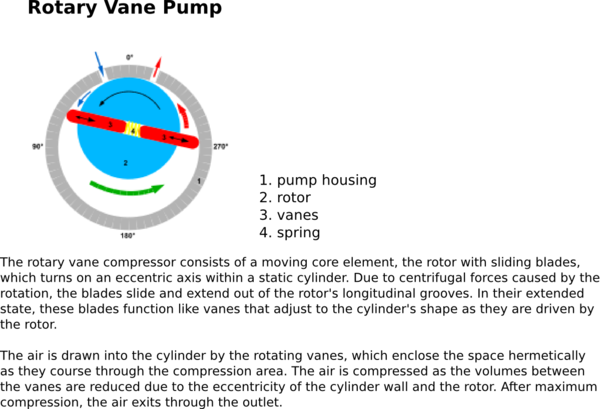Difference between revisions of "Pumping Systems"
| Line 1: | Line 1: | ||
| − | + | Three types of pump systems: '''positive displacement''', '''momentum transfer''', and '''entrapment'''. | |
| − | Positive displacement: Uses a mechanism to repeatedly expand a cavity, allow gases to flow in from the chamber, seal off the cavity, and exhaust it to the atmosphere. | + | == Positive Displacement Pumps == |
| + | Positive displacement: Uses a mechanism to repeatedly expand a cavity, allow gases to flow in from the chamber, seal off the cavity, and exhaust it to the atmosphere. | ||
| − | + | [[File:Rotary_vane_pump.png| 600px]] | |
| − | |||
Momentum transfer: Uses high speed jets of dense fluid or high speed rotating blades to knock gas molecules out of the chamber. Ex: Diffusion and turbo molecular | Momentum transfer: Uses high speed jets of dense fluid or high speed rotating blades to knock gas molecules out of the chamber. Ex: Diffusion and turbo molecular | ||
| − | + | [[File:Cut_through_turbomolecular_pump.jpg|300px]] | |
| − | + | capture gases in a solid or adsorbed state. Ex: Ion and sorption pumps | |
| − | + | [[File:ionpump.jpg]] | |
| − | |||
| − | |||
Revision as of 12:23, 7 November 2014
Three types of pump systems: positive displacement, momentum transfer, and entrapment.
Positive Displacement Pumps
Positive displacement: Uses a mechanism to repeatedly expand a cavity, allow gases to flow in from the chamber, seal off the cavity, and exhaust it to the atmosphere.
Momentum transfer: Uses high speed jets of dense fluid or high speed rotating blades to knock gas molecules out of the chamber. Ex: Diffusion and turbo molecular
capture gases in a solid or adsorbed state. Ex: Ion and sorption pumps


